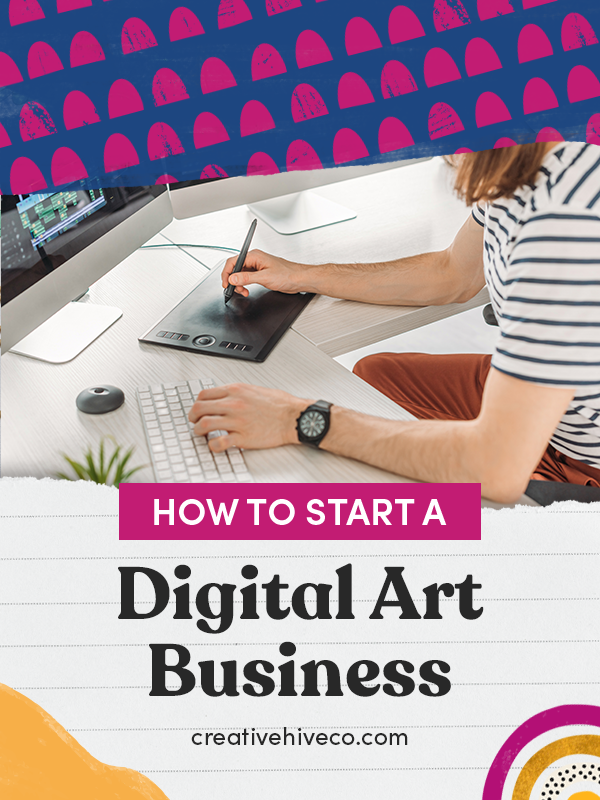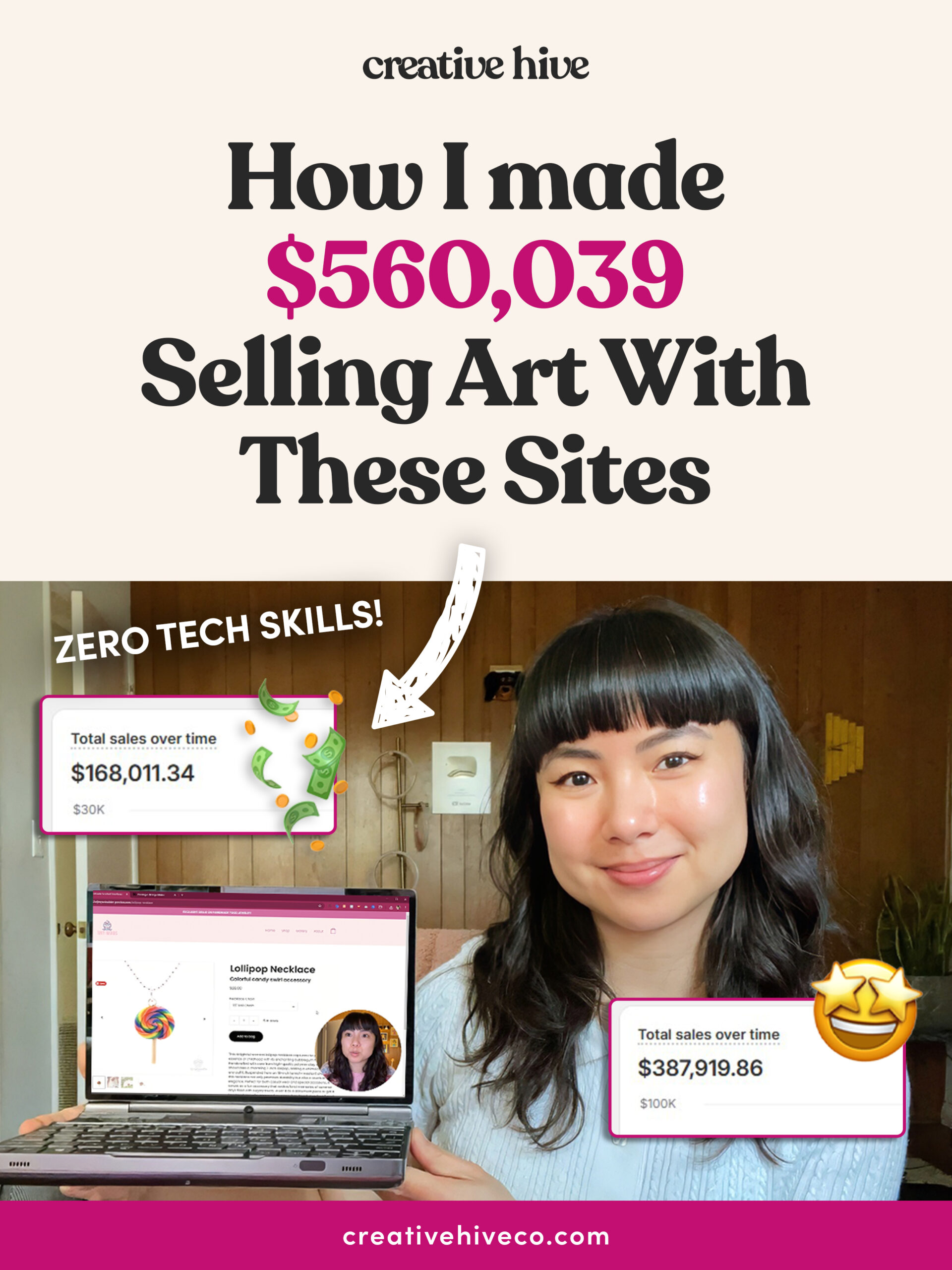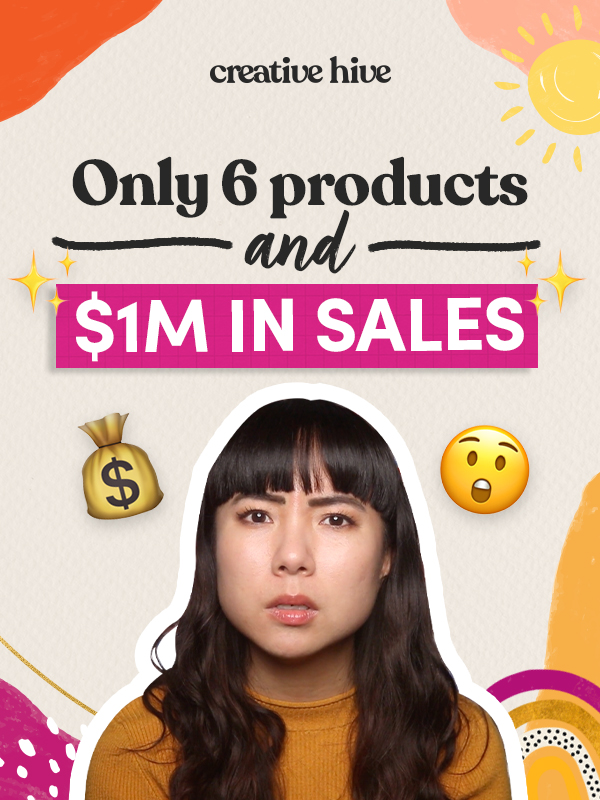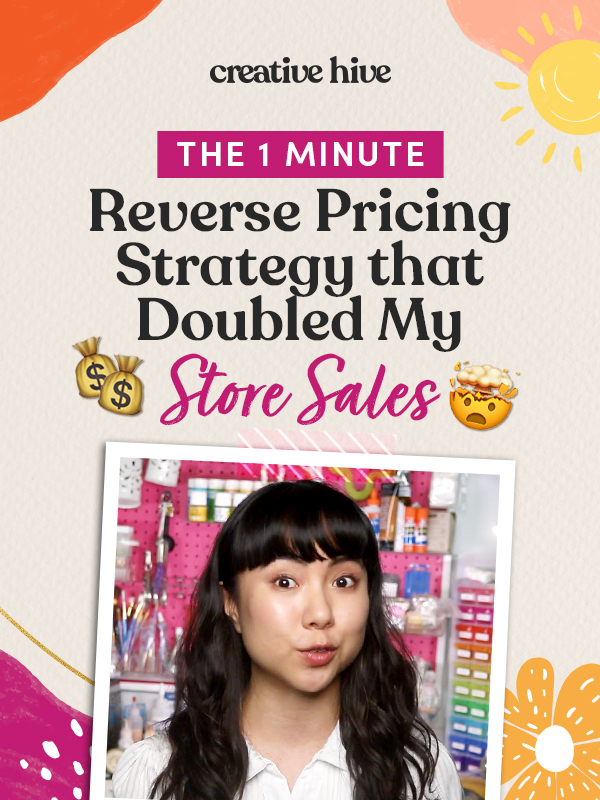I want to help you build a sustainable, profitable handmade business that makes you consistent income and sales. I only ever teach or recommend marketing, social media, pricing, production and branding tips that I’ve personally used successfully in my own 7-figure handmade businesses.
I'm Mei, from Los Angeles!
Read More
Popular Posts You'll Love
Looking for something?
Categories
starting a business
get more traffic
running a business
make more sales
branding
growing a business
mindset & productivity
podcasts
pricing & money
product photography
reviews
selling on etsy
selling on amazon
social media
selling wholesale
- Facebook0
- Twitter10
- Pinterest981
- 991shares
If you’re thinking about starting a digital art business then read this post first!
I’m going to share with you what you need to get started, the challenges you might face, and how to make sure your products stand out from the competition.
So why is a digital art business a good idea?
Digital art is a broad category. Simply put, it’s artwork that’s created using a computer.
This can mean lots of different things. You can draw an illustration on a computer screen that you then color in, take images and render them in Photoshop, do a collage from different photographs, or even use fonts. The options are endless!
The common thread is that all of these artworks are created by using your computer as the main medium. This sets it slightly apart from other kinds of artwork, such as drawing or doing portraits.
Of course, those mediums may use your computer too, but digital art is really focused around the computer as your main art tool.
Advantages to Running a Digital Art Business
There are a lot of advantages to running a digital art business.
1. There are Incredible Growth Opportunities
If you can create artwork that catches on with people, you can sell droves of them and grow a really large following.
A key part of a digital art business is that you’re creating files on your computer that you then can have printed.
So if you create a file that’s really beautiful, you can sell dozens, hundreds, or even thousands of prints. This sets it completely apart from an art business where you’re drawing each individual item.
Because of that, there’s a lot of opportunity for growth.
2. It’s Easier to Outsource
A big part of the digital art business is the customer service and the actual printing of the finished artwork.
Both of these are very easy things to outsource compared to a handmade business that requires you to teach someone else how to do the artwork. For that reason, it’s very easy to scale your work.
It’s also easier to run the business without being overwhelmed. You can outsource the printing and some of your customer service, which is always something I’m looking for in a business.
3. Capability to Cater to the Custom + Memory Making Niche
Say you create beautiful artwork with over the top lettering for someone’s name. Once you create the basics of the file, customizing that artwork to a person is really just changing the name or changing the font.
This sort of business lends itself well to creating custom pieces, and custom things are hot right now!
Everyone wants to commemorate their wedding, engagement, the trip they took, or their new child’s room.
This is a huge market (that’s not going anywhere) and digital art allows you to easily tap into it.
4. Digital Artwork Can Also be Turned Into Printables
You’ll want to watch my other video about how to make your printables business succeed.
5. Price Point
The final reason I love digital art businesses is because you’re looking at a comfortable price point.
I love these mid-range businesses that are charging double digits to low triple digits in terms of price for the finished product.
It depends on the size, but these are much easier businesses to run.
You’re going to have a larger audience and be accessible to a wider range of people as opposed to a luxury goods business, where you’re selling a $5,000 custom painting.
Challenges to Watch For
Let’s move on to some challenges to look out for.
Your Vision
This could be the biggest challenge, you need to have a vision.
I’m going to talk about defining your niche later in this post, but you can’t just put up whatever artwork you feel like you would be drawn to.
You need to have a clear niche that makes a statement and that connects with people.
This is the biggest struggle people have when starting a digital art business; finding their niche and having a vision that connects with people and creates a cohesive shop.
Upfront Production Cost
Say you’re making wedding prints with very stylized bride and groom images. Those images may take you a long time to initially develop. Then with each sale, it may only take you five minutes to customize the file, but there is a large upfront time investment.
Developing your portfolio at the front end can take a pretty good chunk of time.
Client Communication
Client communication can take up a lot of your time, especially if it revolves around events like weddings, engagements, or newborns.
This is a time in the clients’ lives that’s really important to them, so they’ll be more particular than usual. That’s something you need to think about before you begin your business.
- Is client communication something that you’re interested in doing?
- Is it something that you’re good at?
- If answering replies from people makes you super grumpy, then maybe the custom path isn’t right for you?
The success of your digital art business is going to rest, to some degree on your customer service abilities.
Your Suppliers are Crucial
The quality of your print, and how the finished product is received by the customer is absolutely paramount to how the customer regards your final piece.
Finding the suppliers that can do the printing to the standard that you want is really important.
Crowded Marketplace
Lots of people from all around the world have computers and the skillset to create digital art.
Because of that, many people are creating digital art, and getting the physical products printed, by print on demand companies in the US and Canada. This makes the competition huge.
It’s going to be crucial that you distinguish yourself from your competitors.
The plus side is you can start a digital art business anywhere in the world!
The Most Important Part
The most important thing you can do when starting your digital art business is determine your shop’s niche.
I see a lot of businesses going wrong here. You need to offer products that people want and you need to have a niche that connects with people.
If your products aren’t in demand, they aren’t going to sell!
So the question is, how do you figure out what people want?
It’s really important that you establish a niche that has a clear message. Even digital art with a mid-century modern style might be too broad to differentiate yourself from your competitors.
This is a point where you really need to dig deep and think about the tools and materials that you work with, what your skillset is, and what the marketplace really needs right now.
For example, let’s look at the wedding niche. It’s really crowded for digital artists.
You need to think about…
- What makes your artwork different or special?
- Where does your artwork fit in during the wedding process?
- Do you create artwork that can be on display at the wedding, like at the table with the guest book?
- Or do you create the mementos for after the wedding that work off of the bride and groom’s portraits?
Or maybe your artwork style is totally inspired by vintage travel posters and your business is making travel posters from popular locations around the world.
This is where the real research and discovery work has to happen.
Just look around on Google, Etsy, Instagram, Facebook and in magazines and see what’s popular.
Of course you’d never copy what other people are doing, but you need to do some research and see what people are looking for.
Ideally, you’re looking to get into a niche where there aren’t millions of products just like yours being offered.
You also want to avoid diving into a niche that no one’s doing. If no one is doing it, it could mean that people aren’t looking for it. Or it could be a clue that it’s too hard to do.
Let’s say you’re looking at homewares and you see that coasters are trending.
- Could you do your digital artwork on coasters?
- Could you make sets?
- Could you do a set of four coasters with your vintage travel pieces?
It’s all about looking at what’s popular and figuring out how your niche can fill that demand.
Make sure you do your research!
At the end of the day, what you really want is to be at the junction of what you like doing and what’s popular right now.
How are You Different?
Now that you’ve narrowed down your product ideas and you found something people want. Next you have to figure out what makes you different from other shops in your niche.
To find what makes you different, you have to add a little something special that makes your product or business stand out from the rest in the world of digital art.
If you decide to do custom wedding art and in your research you see that a lot of products out there tend to use a certain muted color palette. Then an easy way to stand out and be different is to use really bright and vibrant colors.
Enough people will totally be into that.
Pricing
If your shop is going to be successful, you need to be able to earn enough money.
That part is obvious, but what’s super interesting about digital art is that there is a unique pricing formula as opposed to other handmade businesses.
Digital art, as I said earlier, has a large startup cost.
You’re initially creating your templates or the actual art itself. Then whether you’re selling downloads or prints you have a different pricing infrastructure than someone who, let’s say, knits a hat.
Typically the pricing structure would be based directly on how long it takes you to knit the hat, how much your materials cost, and your profit.
The tricky thing about digital art is you have some cost in terms of time and materials for each order, but you also have a lot of cost that goes into the creation of your product in advance.
So from that perspective, it’s run a lot more like a printables or a recurring income business. This is where pricing gets super tricky.
The one recommendation I have is that you should snoop around and look at what other people in the market are charging for a similar item that you’re offering.
Then you need to realistically think, can I sell enough of this item to make it worth my time?
You need to factor in what the upfront cost of creating a product is and what the per item cost is.
Then your perfect pricing structure marries those two in a way that you can make a consistent living by selling on a weekly basis.
Once you’ve done that research, you’re going to try it out for a little bit and experiment in your own shop. You may have to do some revision after your shop has been open for a month or two.
For example, maybe you’re not selling as many products as you’d like or maybe you’re selling more of one kind, but less of another kind.
Then you go back to the drawing board and change up your formula.
Maybe you decide, you just want to sell the larger prints because they take you the same amount of effort to do, but they make you more money.
That’s where business is a very cyclical sort of thing, but it’s super important to get your pricing right for success.
Process & Distribution of Your Product
Your process makes all the difference here.
- Are you going to make printables that people will download and print themselves?
- Or are you printing it for them?
- Are you making the art yourself?
- Or are you creating the templates that you filled in?
All of these are amazing options, but they drastically change how you run your business.
It’s really important that you spend time thinking about what your normal process will be as you’re developing your products. Is it something sustainable that you can do yourself or do you plan to hire artists in the future?
This is what we do with our new print on demand personalized art business. We have a team of multiple artists that help fulfill orders.
If you’re creating templates or you’re looking for artists, I highly recommend Fiverr, Upwork or Creative Market. This is a place to get some stock of digital materials that you may be using.
They are great resources to start with.
If you’re playing with digital art, you probably already have your software in order.
If you’re printing, I can recommend Printful and Gooten. That’s what we use and they’re both great for different reasons.
Printful is really affordable and fast but Gooten has better quality.
The finished product that the customer receives is going to be the printed item, if that’s the path you go. So it’s really important that it’s in a quality you like and comes out the way you want.
Marketing
First and foremost which platform is your handmade shop going to live on?
I talk about it a lot in my other posts, but it’s worth mentioning again.
It’s super important for you to have your own website instead of relying completely on marketplaces like Etsy or Amazon.
You’re going to want to pop over to this video, to watch why I don’t recommend you putting all of your eggs in the Etsy basket.
You’re also going to want a great collection of product photos.
You can use mockup photos that you can get for free online or paid ones on sites like Creative Market.
Pay extra attention to picking really good mock-up photos because that can also help you stand out from the crowd.
Influencer marketing and outreach as well as Facebook ads are all going to be great ways to promote your new shop.
Once you’ve put so much work into developing your business, you definitely don’t want to drop the ball on your marketing. That’s how sales happen!
If you enjoyed this post or have any questions, leave a comment below.

Leave a Comment
Liked this article? Share it!
Unlock a Profitable Handmade Business
in Just 12 Weeks Without Using Etsy
or Social Media
FREE WORKSHOP
This workshop is for anyone who makes and sells a handmade or physical product, including jewelry designers, artists, paper designers, bath & body product makers and more!
What You'll Discover
The #1 mistake people make with Etsy & social media that causes shops to FLOP
The secret to making it with your handmade shop so it's no longer just a hobby
How to make sales in your handmade shop with ease so you can finally get to 6-figures
TAKE ME THERE
Your email address will not be published. Required fields are marked *
Leave a Reply Cancel reply
About
Blog
A Sale A Day
Student Login
Free Class
Contact
Terms
Become A Student
Watch On YouTube
Student Reviews
See My Handmade Shop!




How can we contact you, i have a brother who i believe is a digital artist genuis, if you would take a look at his paintings you would be amazed.
hi does he have a portfolio online?
Hii, Myself Giftson and I do drawing using my mobile. This is my Instagram handle https://instagram.com/giftsonpauldavidson?utm_medium=copy_link
And I’m thinking to do a business related to this so what would be your suggestions. Do check my ig☺️
Love this article + the Youtube video. So much value and full of useful insights! I am at a place where I’m contemplating whether I love working in digital only or doing physical artwork. Digital can take a lot of stress out of the equation for artists, especially when we have to divide our time between running a website and social media just to promote their brand. I was wondering about copyright issues with digital downloads though. I suppose this is always going to be a risk. I’d think issuing Terms & Conditions of Use when purchasing is good, but I suppose it doesn’t 100% guarantee buyers ‘playing ball’. I think we artists are always a bit precious when it comes to giving away our work and fearing not being adequately remunerated for it. Would love to know your thoughts on this. Thanks for sharing.
These tips make all the difference in an online or physical business.